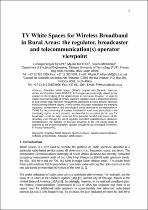 ResearchSpace
ResearchSpace
TV White spaces for wireless broadband in rural areas: the regulator, broadcaster and telecommunication(s) operator viewpoint
JavaScript is disabled for your browser. Some features of this site may not work without it.
- ResearchSpace
- →
- Research Publications/Outputs
- →
- Conference Publications
- →
- View Item
| dc.contributor.author |
Mfupe, Luzango P

|
|
| dc.contributor.author |
Mzyece, M

|
|
| dc.contributor.author |
Mekuria, Fisseha

|
|
| dc.date.accessioned | 2012-11-13T13:38:45Z | |
| dc.date.available | 2012-11-13T13:38:45Z | |
| dc.date.issued | 2012-05 | |
| dc.identifier.citation | Mfupe, LP, Mzyece, M and Mekuria, F. TV White spaces for wireless broadband in rural areas: the regulator, broadcaster and telecommunication(s) operator viewpoint. IST Africa 2012, Dar es Salaam, Tanzania, 9-11 May 2012 | en_US |
| dc.identifier.uri | http://www.slideshare.net/bantugbrolu/luzango-mfupe-ist2012-africa-presentation | |
| dc.identifier.uri | http://hdl.handle.net/10204/6307 | |
| dc.description | IST Africa 2012, Dar es Salaam, Tanzania, 9-11 May 2012 | en_US |
| dc.description.abstract | Television White Spaces (TVWS) coupled with Dynamic Spectrum Access and Cognitive Radio (DSA-CR) technologies are increasingly viewed as key enablers to the bridging of the digital divide in rural areas. However, in order to realize maximum benefits of TVWS, spectrum regulators need to implement reforms to their archaic static spectrum management approaches to allow dynamic spectrum sharing among different players. In this context, this paper investigates the emerging regulatory, standardization, and technological trends necessary to the exploitation of TVWS for the provisioning of wireless broadband in rural areas, particularly in the developing regions. In such scenarios, we show that the incumbent (in this case TV broadcaster) could be better protected from potential harmful interference of the secondary users through the use of regulator controlled spatial-temporal databases. Simultaneously, the delivery of low-cost service(s) to the end-user(s) could be achieved by the telecommunication operator through the use of bridged TVWS/Wi-Fi Access Points (APs). | en_US |
| dc.language.iso | en | en_US |
| dc.relation.ispartofseries | Workflow;9804 | |
| dc.relation.ispartofseries | Workflow;9803 | |
| dc.subject | Cognitive radio | en_US |
| dc.subject | Dynamic spectrum access | en_US |
| dc.subject | Spatial-temporal database | en_US |
| dc.subject | Software defined radio | en_US |
| dc.subject | Television white spaces | en_US |
| dc.subject | TVWS | en_US |
| dc.title | TV White spaces for wireless broadband in rural areas: the regulator, broadcaster and telecommunication(s) operator viewpoint | en_US |
| dc.type | Conference Presentation | en_US |
| dc.identifier.apacitation | Mfupe, L. P., Mzyece, M., & Mekuria, F. (2012). TV White spaces for wireless broadband in rural areas: the regulator, broadcaster and telecommunication(s) operator viewpoint. http://hdl.handle.net/10204/6307 | en_ZA |
| dc.identifier.chicagocitation | Mfupe, Luzango P, M Mzyece, and Fisseha Mekuria. "TV White spaces for wireless broadband in rural areas: the regulator, broadcaster and telecommunication(s) operator viewpoint." (2012): http://hdl.handle.net/10204/6307 | en_ZA |
| dc.identifier.vancouvercitation | Mfupe LP, Mzyece M, Mekuria F, TV White spaces for wireless broadband in rural areas: the regulator, broadcaster and telecommunication(s) operator viewpoint; 2012. http://hdl.handle.net/10204/6307 . | en_ZA |
| dc.identifier.ris | TY - Conference Presentation AU - Mfupe, Luzango P AU - Mzyece, M AU - Mekuria, Fisseha AB - Television White Spaces (TVWS) coupled with Dynamic Spectrum Access and Cognitive Radio (DSA-CR) technologies are increasingly viewed as key enablers to the bridging of the digital divide in rural areas. However, in order to realize maximum benefits of TVWS, spectrum regulators need to implement reforms to their archaic static spectrum management approaches to allow dynamic spectrum sharing among different players. In this context, this paper investigates the emerging regulatory, standardization, and technological trends necessary to the exploitation of TVWS for the provisioning of wireless broadband in rural areas, particularly in the developing regions. In such scenarios, we show that the incumbent (in this case TV broadcaster) could be better protected from potential harmful interference of the secondary users through the use of regulator controlled spatial-temporal databases. Simultaneously, the delivery of low-cost service(s) to the end-user(s) could be achieved by the telecommunication operator through the use of bridged TVWS/Wi-Fi Access Points (APs). DA - 2012-05 DB - ResearchSpace DP - CSIR KW - Cognitive radio KW - Dynamic spectrum access KW - Spatial-temporal database KW - Software defined radio KW - Television white spaces KW - TVWS LK - https://researchspace.csir.co.za PY - 2012 T1 - TV White spaces for wireless broadband in rural areas: the regulator, broadcaster and telecommunication(s) operator viewpoint TI - TV White spaces for wireless broadband in rural areas: the regulator, broadcaster and telecommunication(s) operator viewpoint UR - http://hdl.handle.net/10204/6307 ER - | en_ZA |





